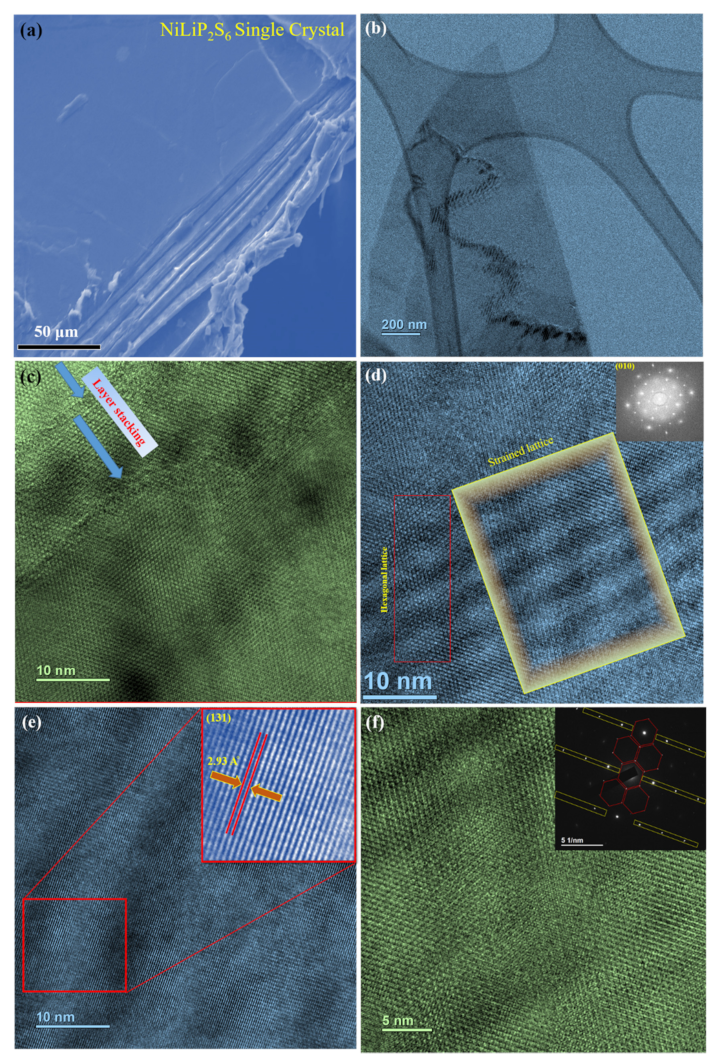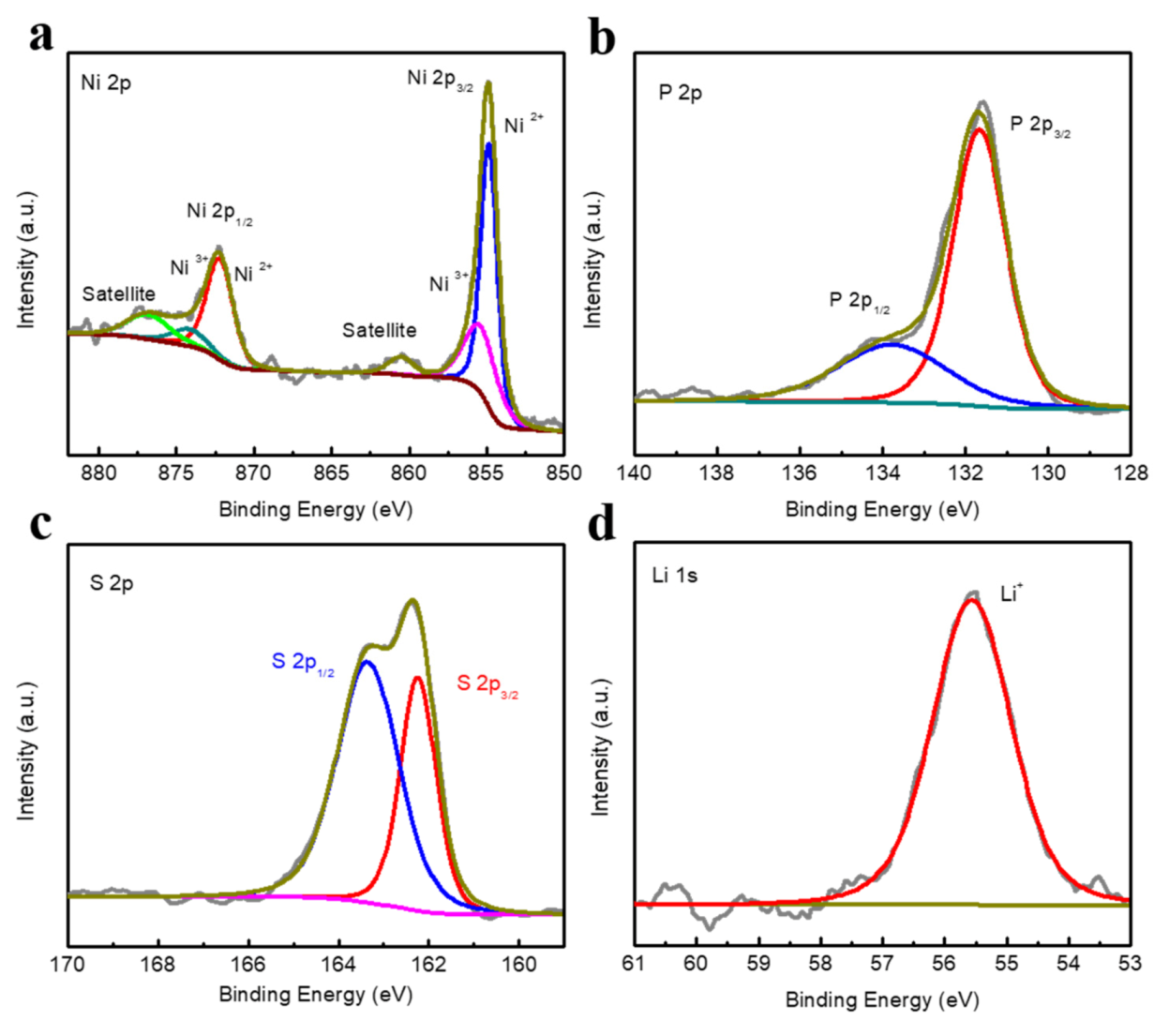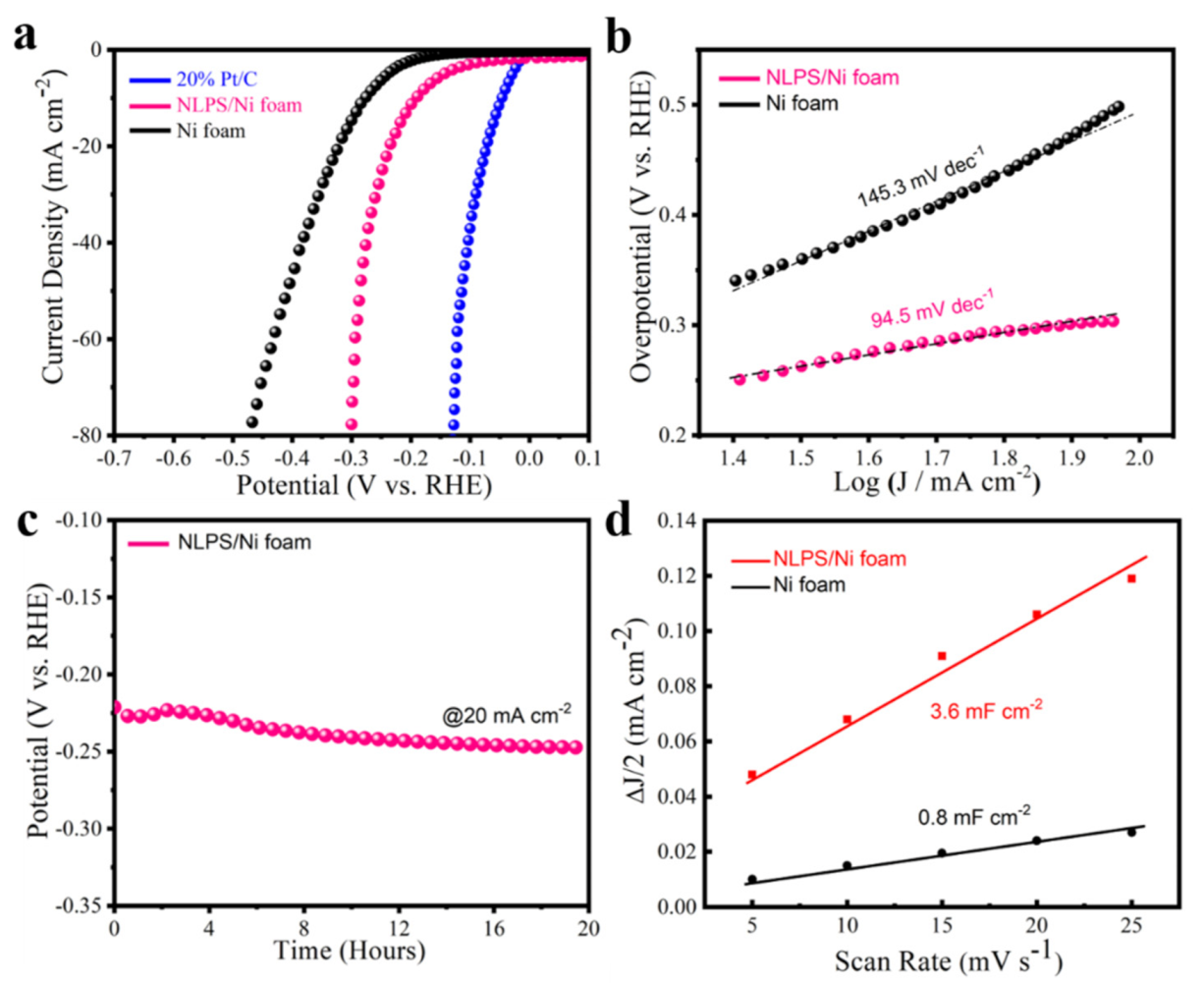Two-Dimensional Layered NiLiP2S6 Crystals as an Efficient Bifunctional Electrocatalyst for Overall Water Splitting
Abstract
:1. Introduction
2. Results and Discussion
3. Materials and Methods
3.1. Preparation of NiLiP2S6 (NLPS) Crystal
3.2. Structural Characterization
3.3. Electrochemical Measurements
3.4. Overall Water Splitting Test
4. Conclusions
Supplementary Materials
Author Contributions
Funding
Conflicts of Interest
References
- De Luna, P.; Hahn, C.; Higgins, D.; Jaffer, S.A.; Jaramillo, T.F.; Sargent, E.H. What would it take for renewably powered electrosynthesis to displace petrochemical processes? Science 2019, 364, eaav3506. [Google Scholar] [CrossRef] [PubMed] [Green Version]
- Tang, C.; Gan, L.; Zhang, R.; Lu, W.; Jiang, X.; Asiri, A.M.; Sun, X.; Wang, J.; Chen, L. Ternary Fe x Co 1– x P Nanowire Array as a Robust Hydrogen Evolution Reaction Electrocatalyst with Pt-like Activity: Experimental and Theoretical Insight. Nano Lett. 2016, 16, 6617–6621. [Google Scholar] [CrossRef]
- Zhang, X.; Zhang, S.; Li, J.; Wang, E. One-step synthesis of well-structured NiS–Ni 2 P 2 S 6 nanosheets on nickel foam for efficient overall water splitting. J. Mater. Chem. A 2017, 5, 22131–22136. [Google Scholar] [CrossRef]
- Shi, H.; Liang, H.; Ming, F.; Wang, Z. Efficient Overall Water-Splitting Electrocatalysis Using Lepidocrocite VOOH Hollow Nanospheres. Angew. Chemie Int. Ed. 2017, 56, 573–577. [Google Scholar] [CrossRef]
- Solmaz, R.; Gündoğdu, A.; Döner, A.; Kardaş, G. The Ni-deposited carbon felt as substrate for preparation of Pt-modified electrocatalysts: Application for alkaline water electrolysis. Int. J. Hydrog. Energy 2012, 37, 8917–8922. [Google Scholar] [CrossRef]
- Morales-Guio, C.G.; Stern, L.-A.; Hu, X. Nanostructured hydrotreating catalysts for electrochemical hydrogen evolution. Chem. Soc. Rev. 2014, 43, 6555. [Google Scholar] [CrossRef] [PubMed] [Green Version]
- Luo, F.; Zhang, Q.; Yu, X.; Xiao, S.; Ling, Y.; Hu, H.; Guo, L.; Yang, Z.; Huang, L.; Cai, W.; et al. Palladium Phosphide as a Stable and Efficient Electrocatalyst for Overall Water Splitting. Angew. Chemie Int. Ed. 2018, 57, 14862–14867. [Google Scholar] [CrossRef]
- Wang, J.; Zhong, H.; Wang, Z.; Meng, F.; Zhang, X. Integrated Three-Dimensional Carbon Paper/Carbon Tubes/Cobalt-Sulfide Sheets as an Efficient Electrode for Overall Water Splitting. ACS Nano 2016, 10, 2342–2348. [Google Scholar] [CrossRef] [PubMed]
- Zhang, B.; Zheng, X.; Voznyy, O.; Comin, R.; Bajdich, M.; Garcia-Melchor, M.; Han, L.; Xu, J.; Liu, M.; Zheng, L.; et al. Homogeneously dispersed multimetal oxygen-evolving catalysts. Science 2016, 352, 333–337. [Google Scholar] [CrossRef] [Green Version]
- Hirai, S.; Ohno, T.; Uemura, R.; Maruyama, T.; Furunaka, M.; Fukunaga, R.; Chen, W.-T.; Suzuki, H.; Matsuda, T.; Yagi, S. Ca 1−x Sr x RuO 3 perovskite at the metal–insulator boundary as a highly active oxygen evolution catalyst. J. Mater. Chem. A 2019, 7, 15387–15394. [Google Scholar] [CrossRef]
- Huang, S.-J.; Muneeb, A.; Sabhapathy, P.; Sheelam, A.; Bayikadi, K.S.; Sankar, R. Tailoring the Co 4+ /Co 3+ active sites in a single perovskite as a bifunctional catalyst for the oxygen electrode reactions. Dalt. Trans. 2021. [Google Scholar] [CrossRef]
- Lado, J.L.; Wang, X.; Paz, E.; Carbó-Argibay, E.; Guldris, N.; Rodríguez-Abreu, C.; Liu, L.; Kovnir, K.; Kolen’ko, Y.V. Design and Synthesis of Highly Active Al–Ni–P Foam Electrode for Hydrogen Evolution Reaction. ACS Catal. 2015, 5, 6503–6508. [Google Scholar] [CrossRef]
- Kibsgaard, J.; Jaramillo, T.F. Molybdenum Phosphosulfide: An Active, Acid-Stable, Earth-Abundant Catalyst for the Hydrogen Evolution Reaction. Angew. Chemie Int. Ed. 2014, 53, 14433–14437. [Google Scholar] [CrossRef]
- Yang, Y.J.; Hu, X. Nanoporous Ni3S2 Film on Ni Foam as Highly Efficient Electrocatalyst for Hydrogen Evolution in Acidic Electrolyte. Russ. J. Electrochem. 2019, 55, 88–96. [Google Scholar] [CrossRef]
- Escalera-López, D.; Niu, Y.; Yin, J.; Cooke, K.; Rees, N.V.; Palmer, R.E. Enhancement of the Hydrogen Evolution Reaction from Ni-MoS 2 Hybrid Nanoclusters. ACS Catal. 2016, 6, 6008–6017. [Google Scholar] [CrossRef] [PubMed] [Green Version]
- Lv, R.; Robinson, J.A.; Schaak, R.E.; Sun, D.; Sun, Y.; Mallouk, T.E.; Terrones, M. Transition Metal Dichalcogenides and Beyond: Synthesis, Properties, and Applications of Single- and Few-Layer Nanosheets. Acc. Chem. Res. 2015, 48, 56–64. [Google Scholar] [CrossRef]
- Kong, D.; Wang, H.; Lu, Z.; Cui, Y. CoSe 2 Nanoparticles Grown on Carbon Fiber Paper: An Efficient and Stable Electrocatalyst for Hydrogen Evolution Reaction. J. Am. Chem. Soc. 2014, 136, 4897–4900. [Google Scholar] [CrossRef] [PubMed]
- Duan, J.; Chen, S.; Jaroniec, M.; Qiao, S.Z. Porous C 3 N 4 Nanolayers@N-Graphene Films as Catalyst Electrodes for Highly Efficient Hydrogen Evolution. ACS Nano 2015, 9, 931–940. [Google Scholar] [CrossRef] [PubMed]
- Académie des Sciences (Paris). National de la recherche scientifique. In Comptes Rendus Hebdomadaires des Séances de l’Académie des Sciences; publiés avec le concours du Centre national de la recherche scientifique par MM; Les Secrétaires Perpétuels: Paris, France, 1835; Volume 1, ISBN 0001-4036. [Google Scholar]
- Brec, R. Review on structural and chemical properties of transition metal phosphorous trisulfides MPS3. Solid State Ionics 1986, 22, 3–30. [Google Scholar] [CrossRef]
- Dziaugys, A.; Banys, J.; Macutkevic, J.; Sobiestianskas, R.; Vysochanskii, Y. Dipolar glass phase in ferrielectrics: CuInP 2 S 6 and Ag 0.1 Cu 0.9 InP 2 S 6 crystals. Phys. Status Solidi 2010, 207, 1960–1967. [Google Scholar] [CrossRef]
- Ismail, N.; El-Meligi, A.A.; Temerk, Y.M.; Madian, M. Synthesis and characterization of layered FePS3 for hydrogen uptake. Int. J. Hydrog. Energy 2010, 35, 7827–7834. [Google Scholar] [CrossRef]
- GARD, P.; SOURISSEAU, C.; OUVRARD, G.; BREC, R. Infrared study of lithium intercalated phases in the LixFeS2 system (0 ⩽ x ⩽ 2). Characterization of a new iron disulfide. Solid State Ionics 1986, 20, 231–238. [Google Scholar] [CrossRef]
- Mayorga-Martinez, C.C.; Sofer, Z.; Sedmidubský, D.; Huber, Š.; Eng, A.Y.S.; Pumera, M. Layered Metal Thiophosphite Materials: Magnetic, Electrochemical, and Electronic Properties. ACS Appl. Mater. Interfaces 2017, 9, 12563–12573. [Google Scholar] [CrossRef] [PubMed]
- Barj, M. Infrared studies of lithium intercalation in the FePS3 and NiPS3 layer-type compounds. Solid State Ionics 1983, 11, 179–183. [Google Scholar] [CrossRef]
- Evans, J.S.O.; O’Hare, D.; Clement, R. The Structure of Co(.eta.-C5H5)2+ and NMe4+ Intercalates of MnPS3: An X-ray, Neutron-Diffraction, and Solid-State NMR Study. J. Am. Chem. Soc. 1995, 117, 4595–4606. [Google Scholar] [CrossRef]
- Liu, J.; Li, X.-B.; Wang, D.; Lau, W.-M.; Peng, P.; Liu, L.-M. Diverse and tunable electronic structures of single-layer metal phosphorus trichalcogenides for photocatalytic water splitting. J. Chem. Phys. 2014, 140, 054707. [Google Scholar] [CrossRef]
- Nathanson, M.; Kanhaiya, K.; Pryor, A.; Miao, J.; Heinz, H. Atomic-Scale Structure and Stress Release Mechanism in Core–Shell Nanoparticles. ACS Nano 2018, 12, 12296–12304. [Google Scholar] [CrossRef]






Publisher’s Note: MDPI stays neutral with regard to jurisdictional claims in published maps and institutional affiliations. |
© 2021 by the authors. Licensee MDPI, Basel, Switzerland. This article is an open access article distributed under the terms and conditions of the Creative Commons Attribution (CC BY) license (https://creativecommons.org/licenses/by/4.0/).
Share and Cite
Huang, S.-J.; Muneeb, A.; Sabhapathy, P.; Bayikadi, K.S.; Murtaza, T.; Raju, K.; Chen, L.-C.; Chen, K.-H.; Sankar, R. Two-Dimensional Layered NiLiP2S6 Crystals as an Efficient Bifunctional Electrocatalyst for Overall Water Splitting. Catalysts 2021, 11, 786. https://doi.org/10.3390/catal11070786
Huang S-J, Muneeb A, Sabhapathy P, Bayikadi KS, Murtaza T, Raju K, Chen L-C, Chen K-H, Sankar R. Two-Dimensional Layered NiLiP2S6 Crystals as an Efficient Bifunctional Electrocatalyst for Overall Water Splitting. Catalysts. 2021; 11(7):786. https://doi.org/10.3390/catal11070786
Chicago/Turabian StyleHuang, Song-Jeng, Adil Muneeb, Palani Sabhapathy, Khasim Saheb Bayikadi, Tahir Murtaza, Kalaivanan Raju, Li-Chyong Chen, Kuei-Hsien Chen, and Raman Sankar. 2021. "Two-Dimensional Layered NiLiP2S6 Crystals as an Efficient Bifunctional Electrocatalyst for Overall Water Splitting" Catalysts 11, no. 7: 786. https://doi.org/10.3390/catal11070786
APA StyleHuang, S. -J., Muneeb, A., Sabhapathy, P., Bayikadi, K. S., Murtaza, T., Raju, K., Chen, L. -C., Chen, K. -H., & Sankar, R. (2021). Two-Dimensional Layered NiLiP2S6 Crystals as an Efficient Bifunctional Electrocatalyst for Overall Water Splitting. Catalysts, 11(7), 786. https://doi.org/10.3390/catal11070786








